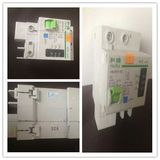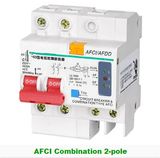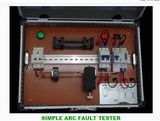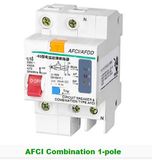| Prod Model: |
AFCI--1-63 |
| Breaking Capacity: |
Low Voltage Circuit Breakers |
| Operation: |
Electric Type |
| Speed: |
High-Speed Circuit Breaker |
| Arc-extinguishing Medium: |
Air |
| Installation: |
Fixed |
| Structure: |
ELCB |
| Poles Number: |
1 |
| Certification: |
ISO9001-2000 |
Product Description
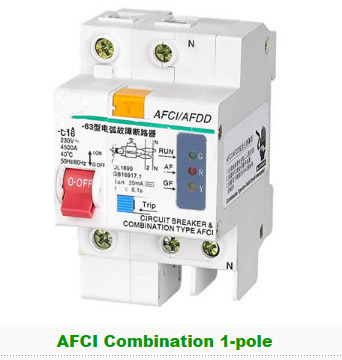
| Feature: |
1.AFCI 1- pole fit electrical fire alarm system branch (16-32A rated current). 2.Communication with 2.4 RF or CAN bus network. 3.Large LCD display, the fault memory function. 4.Buzzer alarm and power off function. 5.Meet 3C/UL1699/IEC62606 standard. 6.Protection function include short circuit, over current, leakage, arc fault, over voltage. |

What is an AFCI Circuit Breaker? (Q&A)
Arc Fault Circuit Interrupters (AFCIs) are required by the National Electrical Code for certain electrical circuits in the home. Below are some frequently asked questions about AFCIs and the benefits of installing them in your home.
What is an Arc Fault?
Why do we really need Arc Fault Circuit Interrupters (AFCIs)?
How is an Arc Fault detected?
How does an AFCI work?
Type of Circuit Breaker AFCIs:
Branch/Feeder
Combination
AFCI and GFCI Protection
What is the difference between and AFCI and Ground Fault Circuit Interrupter (GFCI)?
Are there any wiring and installation guidelines?
What is the price of the new safety technology worth?
Why is it important to have an AFCI Breaker installed in your home?
Where are they required to be installed by the National Electrical Code?
Can I have AFCIs installed even if my state or municipality doesn't require them?
What is an Arc Fault?
Most people are familiar with the term arcing. Arcing may be intended, such as with an arc welder or unintended, such as when a tree falls on a power line during a storm creating a current discharge between conductors or to the ground.
An arc fault is an unintended arc created by current flowing through an unplanned path. Arcing creates high intensity heating at the point of the arc resulting in burning particles that may easily ignite surrounding material, such as wood framing or insulation. The temperatures of these arcs can exceed 10,000 degrees Fahrenheit.
Why do we really need Arc Fault Circuit Interrupters (AFCIs)?
Smoke alarms, fire extinguishers and escape ladders are all examples of emergency equipment used in homes to take action when a fire occurs. An AFCI is a product that is designed to detect a wide range of arcing electrical faults to help reduce the electrical system from being an ignition source of a fire. Conventional overcurrent protective devices do not detect low level hazardous arcing currents that have the potential to initiate electrical fires. It is well known that electrical fires do exist and take many lives and damage or destroy significant amounts of property. Electrical fires can be a silent killer occurring in areas of the home that are hidden from view and early detection. The objective is to protect the circuit in a manner that will reduce its chances of being a source of an electrical fire.
How is an Arc Fault detected?
Unlike a standard circuit breaker detecting overloads and short circuits, an AFCI utilizes advanced electronic technology to "sense" the different arcing conditions. While there are different technologies employed to measure arcs by the various AFCI manufacturers, the end result is the same, detecting parallel arcs (line to line, line to neutral and line to ground) and/or series arcs (arcing in series with one of the conductors).
How does arc fault detection work? In essence, the detection is accomplished by the use of advanced electronic technology to monitor the circuit for the presence of "normal" and "dangerous" arcing conditions. Some equipment in the home, such as a motor driven vacuum cleaner or furnace motor, naturally creates arcs. This is considered to be a normal arcing condition. Another normal arcing condition that can sometimes be seen is when a light switch is turned off and the opening of the contacts creates an arc.
A dangerous arc, as mentioned earlier, occurs for many reasons including damage of the electrical conductor insulation. When arcing occurs, the AFCI analyzes the characteristics of the event and determines if it is a hazardous event. AFCI manufacturers test for the hundreds of possible operating conditions and then program their devices to monitor constantly for the normal and dangerous arcing conditions.
How does an AFCI work?
In essence, the detection is accomplished by the use of advanced electronic technology to monitor the circuit for the presence of "normal" and "dangerous" arcing conditions. Some equipment in the home, such as a motor driven vacuum cleaner or furnace motor, naturally create arcs. This is considered to be a normal arcing condition. Another normal arcing condition that can sometimes be seen is when a light switch is turned off and the opening of the contacts creates an arc.
Types of Circuit Breaker AFCIs
AFCIs are intended to mitigate the effects of arcing faults by functioning to de-energize the circuit when an arc fault is detected. AFCIs are required by the NEC® to be a listed product. This means that they must be evaluated by a nationally recognized testing laboratory to the national standard for AFCIs (UL 1699). NEC 210.12 establishes the requirement to use AFCIs. Protection is required for branch circuits in locations as specified in this NEC® rule.
Branch/Feeder Breaker AFCI
A device intended to be installed at the origin of a branch circuit or feeder, such as at a panelboard. The branch/feeder AFCI provides for detection of arcing faults that can occur line-to-line, line-to-neutral and line-to-ground. To be able to handle shared neutral circuits (a common application in older homes), a two-pole AFCI can be used. This will accommodate the three-wire circuit arrangement used in shared neutral applications.
Combination Breaker AFCI
In addition to the protection provided by the Branch Feeder AFCI, the Combination AFCI provides for series arc detection down to 5 amperes. This series arc detection is beneficial to detect lower level arcing in both branch circuits and power supply cords. Combination AFCI protection is required by the NEC® as of January 1, 2008.
Breaker AFCI and GFCI Protection
An AFCI can be used in conjunction with GFCI protection to provide both arcing fault protection as well as 5mA ground fault (people) protection. A common way to provide both types of protection is to use an AFCI circuit breaker and a GFCI receptacle. AFCIs can also incorporate 5mA GFCI protection into the same package. This solution for AFCI breaker and GFCI on the same circuit can be useful where the circuit design requires both types of protection or where the installer (or user) wants to have both types of protection.
What is the difference between and AFCI and Ground Fault Circuit Interrupter (GFCI)?
There is a major difference between the functioning of an AFCI as compared to a GFCI (Ground Fault Circuit Interrupter). The function of the GFCI is to protect people from the deadly effects of electric shock that could occur if parts of an electrical appliance or tool become energized due to a ground fault. The function of the AFCI is to protect the branch circuit wiring from dangerous arcing faults that could initiate an electrical fire.
AFCI and GFCI technologies can co-exist with each other and are a great complement for the most complete protection that can be provided on a circuit.
Are there any wiring and installation guidelines?
There are no special requirements of an AFCI circuit other than proper installation and wiring practices. There are various special considerations that must be given to certain circuits that vary from the norm, such as shared neutral applications, but in general the application of a breaker AFCI is as simple as following the installation instructions that come from the manufacturer.
The basic difference between installing the breaker AFCI versus a standard thermal magnetic circuit breaker is the requirement to connect both the hot and neutral conductor to the proper terminals of the breaker AFCI. In a circuit wired with a conventional circuit breaker, the hot conductor is connected to the breaker and the neutral conductor is connected directly to the neutral bar of the load center.
Why is it important to have an AFCI Breaker installed in your home?
AFCIs were developed in response to an identified electrical problem causing fires in the home as noted by the Consumer Product Safety Commission and other prominent organizations. An AFCI breaker provides a higher level of protection than a standard circuit breaker by detecting and removing the hazardous arcing condition before it becomes a fire hazard.
Can I have AFCIs installed even if my state or municipality doesn't require them?
Absolutely, do you only place locks on the front door of the house? Just like placing locks on all external doors and windows for security reason, it is logical to request AFCI protection on all 15 and 20A branch circuits, not just those in the bedroom, to protect the entire home from an electrical arcing ignition hazard.
AFCIs are available through electrical distributors and in many home centers and hardware stores nationally. The only major physical requirement is that the AFCI breaker requires directly wired hot and neutral wires on the circuit you're going to protect.
If any questions fell free to contact with us.
ATT:wendy
Zhongrui Electric Co., Ltd. Located at Chinese Electric City'-Yueqing City, established 2000, own advanced manufacturing machines and complete measuring & testing equipments. We are a high technical enterprise that have succeed in turning produce, develop and sell together, one of the professional manufacturer for silicone rubber insulator in China, the member of Chinese Electrical Equipment Industry Association, one unit of National standard and technical committee of insulator, Yueqing city valuing contracts & promising enterprise, ISO2000: 2008 International Quality System Attestation enterprise, and established long-term cooperating relationship with the relevant scientific research institutions.
Our company specializes in the series products of composite insulator (power line, substation and electric railway series), composite dry wall bushing, lightning arrester and fuse cutout etc. All products are qualified by Ministry of Power Industry electric equipment quality inspection center and National Insulator & Lightning Arrester quality control test of inspection center, agreed with National industrial, IEC AND ANSI standard, and accreditation through State Power Corporation and China Machinery Industry Federation 'Two Ministry' new product and Zhejiang Province Scientific & Technological Hall, Province Electric Power Industry Bureau, Province Mechanical Industry Bureau federation authentication of new products of scientific & technical results. Product quality is insured by People's Insurance Company of China. Series of composite insulators and Zinc Oxide Arrester manufactured by our company, sharing the features of advanced design, reasonable structure, reliable performance, that achieve to the national leading level. Our silicone Rubber insulator used on high-voltage line had been placed 'National Star plan' by Chinese Technical department, Composite Cross-arm Insulator had been honored City Technical Metal; And we are the first private enterprise that got KEMA test report for Composite Insulator and Arrester in China. Our products sell well through all parts of the country, as well as finding good markets in Iran, Indonesia, Vietnam, Kampuchea, Syrian, Korean, Canada etc., gaining favorable comments of domestic and abroad users.
We can designand produce all type composite Insulators as per user's requirement. Warmly welcome old and new customers visit our company. We try our best to develop the best products at highvoltage products basic with "toward excellence for creditable brand"
ZONRI company will go ahead together with you and cooperate with you in sincerely.





